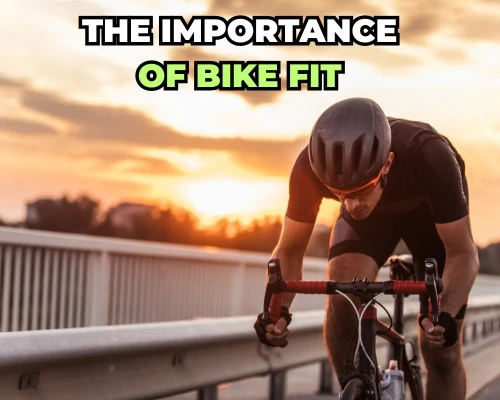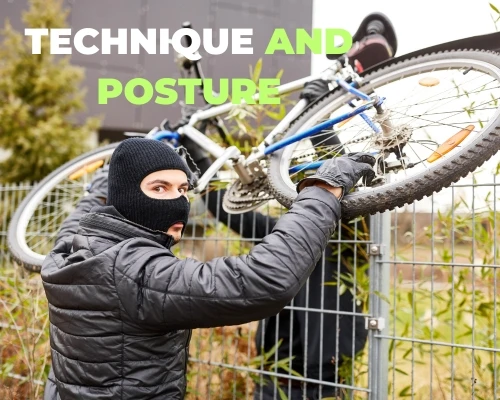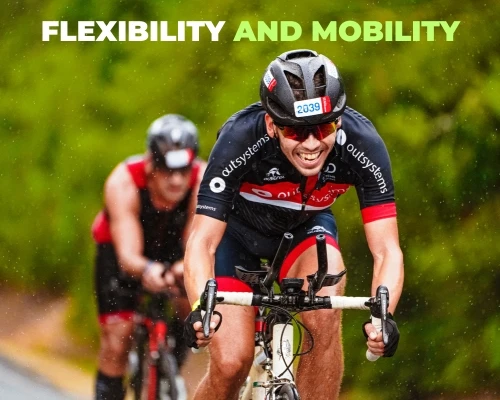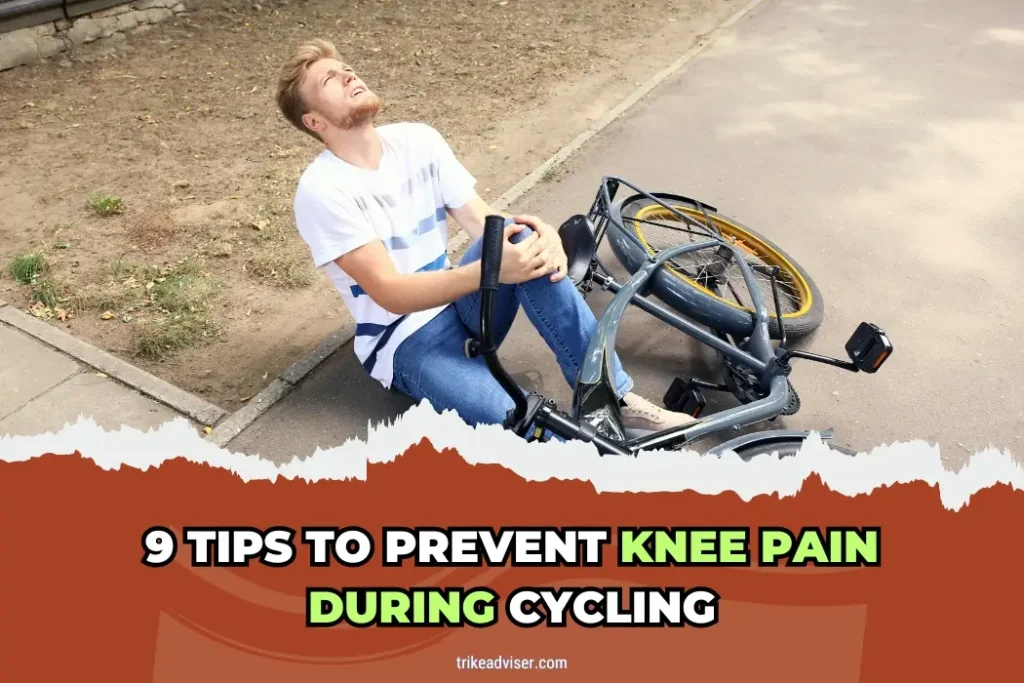Knee pain while cycling? It’s more common than you think. A silent ride turns into a series of grimaces with each pedal stroke. It’s the uninvited guest on every ride, lurking.
You’ve adjusted the seat, tried new shoes, even pedaled differently. Nothing seems to work. It’s frustrating, right? Here lies the rub: most cyclists face this at some point.
But, it’s not a rite of passage. Nor is it something to ignore. The solution isn’t as elusive as it seems. The right tips can transform pain into pleasure, struggle into smooth sailing. Welcome to a guide that does just that. Ready to make knee pain a distant memory? Let’s roll.
9 Tips to Prevent knee pain During Cycling
Jumping in too deep, too soon? That’s a recipe for trouble. Begin with modest workouts. Ease into longer rides. This gradual climb allows your body to adapt without screaming for mercy. Patience pays off. Rushing only invites pain. Remember, Rome wasn’t built in a day, nor is your cycling endurance.
1. Proper Footwear
Your feet, the unsung heroes, need the right armor. Cycling shoes with stiff soles aren’t just fancy; they’re essential. They maximize your power and keep your feet happy. No squishing, no imbalances. Think of them as your foundation. Solid ground leads to pain-free rides.
2. Ice Therapy
Feel the burn? Cool it down. Ice isn’t just for drinks. It reduces inflammation, numbs the pain. Apply for 15-20 minutes, give your skin a break, then repeat. Do this two to three times a day. It’s like giving your knees a chill pill.
3. Heat Therapy
Heat brings life. It boosts circulation, eases muscles, and whispers sweet nothings to your discomfort. Just remember, timing is everything. Acute injury? Hold off on the heat. Otherwise, let the warmth seep deep, making flexibility your friend.
4. Consult a Doctor
When in doubt, turn to the pros. Persistent symptoms? Swelling that won’t quit? A doctor can decode your knee’s distress signals. Sometimes, the issue is deeper than you think. Expert advice is your roadmap to recovery.
5. Foam Rolling
Imagine a massage without the spa. Foam rolling smooths out those tight muscles, bringing relief and improving flexibility. It’s self-care with a twist, literally. Roll your way to relaxed muscles and say goodbye to unnecessary tension.
6. Maintain Proper Bike Fit
The throne upon which you sit, your saddle, holds the key. Too high or too low, and your knees pay the price. Aim for that sweet spot where your knee slightly bends at the pedal’s lowest point. This isn’t just about comfort; it’s about preventing pain.
7. Cross-Training
Variety is the spice of life, and your muscles agree. Strength training, yoga, swimming—these aren’t just for fun. They build the muscles around your knee, fortifying your body’s natural defense system against pain. Balance is strength.
8. Glute Strengthening
Your glutes, those powerhouse muscles, play a starring role. They keep your knees in line, preventing the dreaded “cave-in.” Target them with exercises that make them stronger and more supportive. Strong glutes equal a stable ride.
9. Strength Training
Beyond the bike, there’s a world of strength to be gained. Full-body workouts twice a week address the biomechanical issues lurking beneath the surface. Strengthen your body, and you cushion your knees against the impact of cycling.
The Importance of Bike Fit

Understanding the intricate dance between rider and bicycle reveals the heart of cycling joy. A harmony, when struck, elevates the ride. At the core of this harmony? Bike fit.
How Bike Fit Affects Knee Health
Proper Alignment: A Cornerstone of Knee Health
- A well-fitted bike aligns the stars: your knees, pedals, and bike. This celestial alignment keeps knee strain at bay.
- Misalignment, on the other hand, is the root of all knee evil. It’s the unseen force that pulls, twists, and ultimately harms.
The Foot/Pedal Interface: Your First Line of Defense
- Here, the battle for knee health is won or lost. A correct foot position on the pedal wards off unnatural knee movements. The result? A smoother ride, free of knee complaints.
Saddle and Handlebars: The Support Crew
- Too high, too low, too far or near—the saddle’s positioning is critical. It dictates the bend and stretch of your knee with each pedal stroke.
- Handlebars, though seemingly distant, influence your posture. They decide the load your knees bear. Optimal positioning equals distributed strain, sparing your knees undue stress.
Professional Bike Fitting vs. DIY Adjustments
The Professional Touch: Precision and Expertise
- Imagine a tailor, but for your ride. Professionals, equipped with tools and knowledge, measure, adjust, and fine-tune. Every aspect of your biking posture is considered, from heel to head.
- They delve deep, beyond the surface. Riding goals, health history, even the minutiae of body mechanics are scrutinized. The outcome? A fit so precise, it feels like flying.
DIY Adjustments: A Game of Guesswork
- The DIY route is tempting. It speaks to the tinkerer in all of us. Yet, this path is fraught with pitfalls. What seems right might be a misstep, leading you away from comfort and closer to injury.
- Critical elements, easily overlooked by the untrained eye, can result in a less-than-ideal setup. It’s the difference between thriving and surviving on your bike.
Technique and Posture

The art of cycling transcends mere motion; it’s a ballet between body and machine, where technique and posture hold the key to a pain-free performance. Herein lies the foundation for knee preservation.
The Role of Pedaling Technique in Preventing Knee Pain
A Symphony of Movement
- Proper pedaling is akin to a well-conducted orchestra. Each muscle, each movement in perfect harmony, reduces the knee’s burden. Dissonance in form invites trouble.
The Mechanics of Motion
- A smooth pedal stroke is the goal. It’s about minimizing the knee’s lateral dance, keeping it a straight and noble passage through each rotation.
- Foot alignment on the pedal is paramount. Imagine your foot as the compass guiding your knee. Misalignment here echoes up into discomfort.
Beyond Technique: The Shield Against PFPS
- Patellofemoral Pain Syndrome (PFPS) lurks in the shadows of poor form. Good technique is your armor, warding off this common adversary.
Optimal Cycling Posture for Knee Health
The Foundation: Bike Fit
- Saddle height is not mere preference; it’s precision. The right height ensures a slight bend in the knee at the pedal’s nadir, a key to unlocking comfort.
- This adjustment is the cornerstone of optimal posture, reducing undue strain on your knees, a vital step toward longevity in cycling.
The Core of Stability
- A neutral spine, the backbone of good posture, prevents compensatory habits that can lead to pain.
- Core engagement is not just for aesthetics. It’s the anchor keeping you stable, preventing the rock and sway that taxes the knees.
A Balanced Act
- True balance in cycling is achieved not just through physical alignment but through the harmony of movement. It enhances performance, sidesteps injuries, and elevates the ride to a realm of comfort.
Flexibility and Mobility

In the realm of cycling, where each pedal stroke is a testament to endurance, flexibility, and mobility emerge as unsung heroes, guarding against the specter of knee pain.
Key Stretches for Cyclists to Prevent Knee Pain
Flexibility is the silent ally of every cyclist, a shield against the assaults of rigidity and strain.
Gluteal Stretch: The Foundation of Flexibility
- Begin with a simple embrace: knee to chest. This not only opens the heart but more importantly, stretches the glutes.
- With a hand guiding your knee across the body, you’re not just stretching; you’re inviting balance back into your life.
Hip Flexor / ITB Stretch: The Path to Harmony
- A pillow, a chair, and a moment of contemplation. This setup isn’t just for comfort; it’s a strategic alignment against tightness.
- Your knee, cushioned and bent, whispers thanks as your hip flexors and ITB stretch, releasing the day’s tension.
Quadriceps Stretch: The Balancing Act
- Facing away from a table, you find an unexpected ally in gravity. As you lean back, the quadriceps stretch, a gentle yet profound push against the frontiers of flexibility.
Incorporating Mobility Work into Your Routine
Mobility, the dance of joints and muscles in their purest form, enhances not just cycling performance but the very quality of movement itself.
Foam Rolling: The Art of Self-Massage
- The foam roller, a simple cylinder of potential, becomes the masseuse to your tired muscles. It’s a journey along the IT band and quadriceps, a quest for release and relief.
Dynamic Stretches: The Prelude to Action
- Before the wheels begin to turn, dynamic stretches set the stage. This series of movements warms the body, a ritual of readiness for the road ahead.
Strength Training: The Pillar of Support
- Beyond the bike, strength training awaits. It’s a commitment to core stability and lower body strength, foundational elements for cycling’s demands.
Regular Stretching: The Constant Companion
- Stretching, a practice as routine as the ride itself, ensures flexibility remains a constant companion. In the quiet moments post-ride or on rest days, it’s an act of preservation, a safeguard against imbalances.
Advanced Tips and Tricks
Embarking on a cycling journey transcends the mere act of pedaling. It’s an intricate dance of technique, equipment, and unwavering attention to the minutiae of movement and alignment. For those seeking to refine their ride, here are insights into safeguarding the keystone of mobility: the knees.
Fine-tuning Your Cycling Technique and Equipment for Optimal Knee Health
Dynamic Bike Fit: The Evolution of Comfort
- Embrace the dynamism of bike fitting. It’s more than a static set-up; it’s an ongoing dialogue with your ride. Adjustments tailored to alleviate anterior knee pain can transform discomfort into harmony.
- This proactive approach, especially when knee discomfort whispers warnings, can recalibrate your connection to the cycle, ensuring every journey is a stride towards knee preservation.
Biomechanical Considerations: The Internal Symphony
- The anatomy of motion hides secrets to pain-free cycling. Ankle pronation, tibial torsion, and the tightness of muscles—these are not mere terms but pivotal elements influencing knee health.
- Addressing these through meticulous bike fit adjustments and flexibility efforts unveils a path free from the shadows of pain.
Confronting Patellofemoral Pain Syndrome (PFPS)
- PFPS, a common adversary, demands strategic countermeasures. Saddle height and position adjustments become tools in your arsenal, reducing the forces that challenge the patellofemoral joint.
- Correcting saddle tracking is not just an adjustment; it’s a declaration of resilience against PFPS.
Muscle Activation Training: The Precision of Movement
- Engage in the art of muscle activation. Utilizing biofeedback and the keen eye of high-speed cameras, identify and correct the subtle misalignments that mar the cycling experience.
- Through targeted exercises, orthotics, or cleat adjustments, forge a kinship between muscle and movement, ensuring a symphony of efficiency and reduced knee strain.
Long-term Strategies for Maintaining Knee Health in Cycling
Preventative Strength Training: The Pillars of Endurance
- Strength training emerges not as an option but a necessity. Squats, lunges, and leg presses build the bastions of stability, enhancing the endurance of the knees against the rigors of cycling.
- This disciplined practice fortifies the lower extremities, supporting proper knee kinematics and ushering in an era of sustained health.
Flexibility and Stretching: The Rituals of Mobility
- Stretching is the thread that weaves through the fabric of knee health. Hamstrings, quadriceps, and hip flexors, when limber, speak the language of fluidity and ease.
- Incorporate a stretching regime that pays homage to flexibility, mitigating the risk of overuse injuries and ensuring the dance of cycling remains a joyous one.
Professional Consultation: The Compass of Health
- In the quest for optimal knee health, professional guidance is the north star. Physiotherapists and bike fitting experts become allies in this journey, offering insights that illuminate the path forward.
- Regular consultations serve as checkpoints, ensuring that your technique and equipment evolve in harmony with the principles of knee preservation.
As an Amazon Associate, I earn from qualifying purchases, at no additional cost to you. Read Our Affiliate Disclosure.

